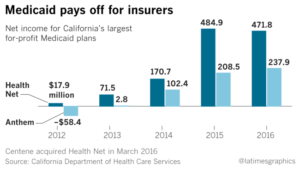
It’s been more than two years since the Affordable Care Act, which you probably know better as Obamacare, went into full effect for individual consumers, and in that time the new health law has enrolled about 12.7 million people. Note that this doesn’t take into account the millions of Americans who’ve been able to get health insurance through the expansion of Medicaid and CHIP within their respective states. In total, 31 states chose to accept federal money and expand their Medicaid program to provide healthcare to low-income individuals and families.
On the surface, Obamacare has led to a statistically meaningful reduction in the number of people who are uninsured. Gallup’s most recent survey in the first quarter pegged the uninsured rate at 11%, which is down 90 basis points from the fourth quarter, and is 6.1% lower than Q4 2013, the quarter prior to the full implementation of Obamacare. The program has presumably opened the door for millions of lower-income Americans and those with pre-existing health conditions to get the medical care they need.
But Obamacare has also opened the door to another set of problems that question its ongoing survival.
An Obamacare exodus
For instance, UnitedHealth Group (NYSE: UNH), the largest insurer in the U.S., recently announced that it would be vacating a majority of the 34 states it’s currently operating in beginning in 2017. The reason? Higher member utilization rates and the ease with which consumers can change health plans are set to cause UnitedHealth to lose around $500 million on its Obamacare individual marketplace plans in 2016. Mind you, we’re talking about the largest U.S. health insurer — a company that’s versed in how to sustain profitability — waving the white flag in most states.
And it’s not just UnitedHealth. Humana has also threatened to pack up shop due to losses suffered on Obamacare exchanges. Also, more than half of all of Obamacare’s approved healthcare cooperatives closed up shop heading into 2016 due to unsustainable losses and an insufficiently funded risk corridor, which was designed to protect money-losing insurers by taking money from insurers that were raking in the dough hand over fist.
With competition likely decreasing rather than increasing on Obamacare’s marketplace exchanges, and insurers clearly in need of higher premium pricing in order to make a sustainable profit, the fear all along has been that premium prices in 2017 were going to go way up.
Insurer rate requests begin rolling in, and they’re downright scary
Recently, two states — Virginia and Oregon — lifted the covers on preliminary rate requests from insurers in 2017. Note the emphasis on “preliminary”, as double-digit percentage rate hike requests will need to be approved by each state’s respective Office of the Insurance Commissioner. Rate hikes are often due in May, because it can take months for OICs to review and validate rate requests.
In spite of these rate requests being preliminary and subject to change, the early data is chilling and suggestive of huge premium price hikes coming consumers’ way in 2017.
In Virginia, national insurer Aetna (NYSE: AET) announced an average premium rate hike request averaging 13% for its Aetna Managed Choice segment, while Innovation Health, a joint-venture between Aetna and Inova, is requesting an average premium hike of 16.6%. Anthem HealthKeepers, a component of Anthem Blue Cross Blue Shield, is requesting an average rate hike of 15.8%. Overall, Virginia’s rate request data is still trickling in, and it very well could change many times over prior to the start of open enrollment — but according to Obamacare data aggregators ACASignUps.net, the weighted average of the 13 received rate requests is nearly 18%.
Things are looking even worse in Oregon, which released proposed health insurance rate requests earlier this month. The individual market offers a veritable sea of double-digit percentage rate hikes, topping out with Moda Health Plan and Oregon’s Health Co-Op, which are both requesting average rate hikes of 32%. Providence Health Plan is nipping at their heels with an average rate hike request of 29.6%. These three health plans comprise practically three-quarters of all enrollees in Oregon’s individual Obamacare marketplace, implying a weighted average increase per ACASignUps.net of 27%! Ouch!
Three reasons big rate hike requests could be the new norm:
Worst of all, it doesn’t appear as if insurer rate hike requests are going to ebb once we get beyond 2017. Three factors in particular suggest that insurers will need rapidly accelerating premiums in order to sustain their Obamacare plans.
First, young adult enrollment simply hasn’t been as high as expected. Young adults are typically healthier, meaning they’re less likely to head to the doctor. Thus, the premiums paid by young adults can be used by health insurers to help offset the medical costs of treating older and/or sicker patients.
What’s holding young adult enrollment back? I’d opine it could be the individual mandate, which is the actionable component of Obamacare that “mandates” consumers buy health insurance or face a penalty come tax time. The penalty, in many cases, is still considerably lower than the annual cost of purchasing even the cheapest health plans (i.e., bronze level). In 2016 it’s the greater of $695 or 2.5% of your modified adjusted gross income. Unless the mandate penalties are considerably higher, it could be tough to convince healthier young adults to enroll.
Secondly, in 2017 we’re going to see the risk corridor go away. To be clear, it’s not as if the risk corridor worked as expected in the first place. In 2016, insurers that were losing money on Obamacare’s exchanges requested $2.87 billion in financial assistance. Unfortunately, the risk corridor doled out just $362 million, or 13% of what was requested. This is the primary reason that more than half of Obamacare’s approved healthcare co-ops closed up shop heading into 2016. Further, without the risk corridor protecting new insurance entrants, there could be little incentive for increased competition, especially from smaller or regional players.
Finally, insurers can likely get away with big premium hikes because the vast majority of consumers enrolled through Obamacare (around 85%) receive Advanced Premium Tax Credits, which you may know better as “subsidies.” Receiving a subsidy helps shield all but about 2 million of Obamacare’s enrollees from potentially devastating hikes in their monthly payments. Of course, the other 2 million enrollees (including yours truly) could be in for some major sticker shock, as could the federal government, which is picking up the tab on these subsidies.
It’ll definitely be interesting to see if Obamacare survives the upcoming election — Hillary Clinton has proposed building on Obamacare’s success, while Donald Trump is focused on its repeal – and if it does, what changes to the program might ensue with Barack Obama out of the Oval Office. But for the time being it’s hard to ignore that the underlying principle of the program, namely affordability, appears to be headed in the wrong direction.
Questions about Insurers and reimbursement? Physician Credentialing and Revalidation ? or other changes in Medicare, Commercial Insurance, and Medicaid billing, credentialing and payments? Call the Firm Services at 512-243-6844 or credentialing@thefirmservices.com

